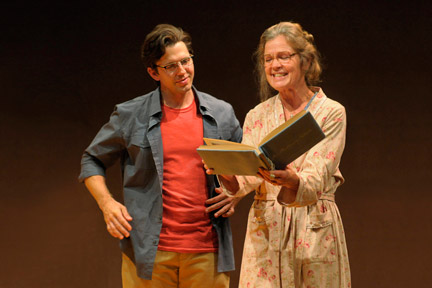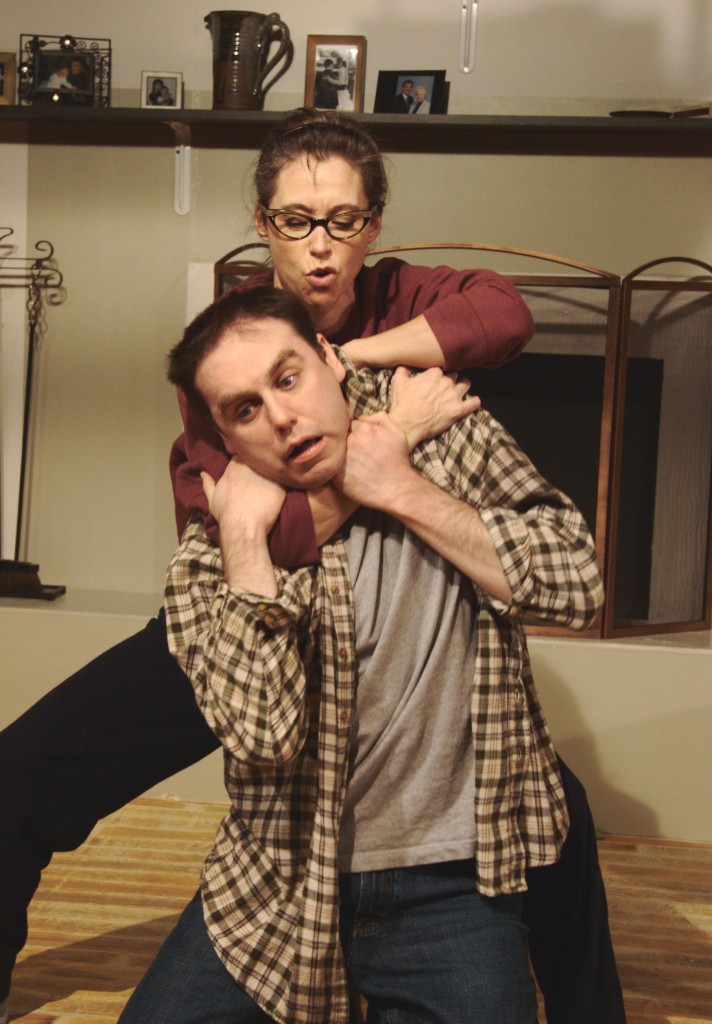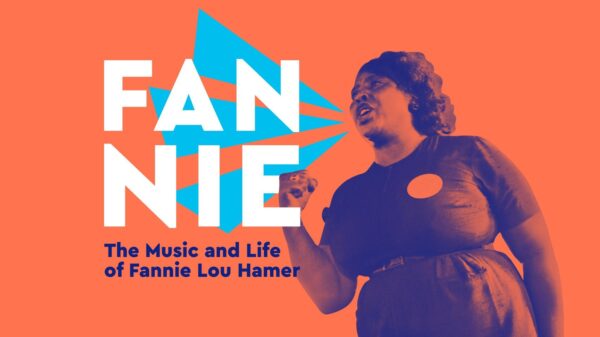Review: How to Write a New Book for the Bible by Bill Cain. Directed by Kent Nicholson. With Aaron Blakely, Linda Gehringer, Leo Marks and Tyler Pierce. Now through February 5 at Seattle Repertory Theatre.
Review: Cradle and All by Daniel Goldfarb. Directed by J.D. Lloyd. With Alyson Bedford and Matthew Middleton. At Theater Schmeater now through February 18.

Tyler Pierce as Bill and Linda Gehringer as Mary in Seattle Rep's "How to Write a New Book for the Bible". Photo: Kevin Berne
Yes, being a theater critic is HARD! If you’re going to be a comprehensive critic, you need to see a wide variety of theater even if that means choking down your revulsion for anything involving Neil Simon, Yasmina Reza, or Kathie Lee Gifford. And, not only is it tough to work up enthusiasm for theater writers that you disdain, it’s also a chore when the theme and plot lines of a work involve things that are of little to no interest to you personally. It’s easy to work up some excitement for a show called “RoboPop!” since it’s apparently about robots (awesome) and pop music (awesome) and it has an exclamation point in the title. But, it’s far tougher to get excited about something called “How to Write a New Book for the Bible” (Bibles: not so awesome, at least in my opinion) or “Cradle and All” (Babies: Adorable in theory, but not always so adorable in actuality, again, also my opinion).
Bill Cain’s new play at Seattle Rep isn’t really about the Bible, but spirituality is a subtle thread throughout the play and it’s not a big surprise…Mr. Cain is both playwright and Jesuit priest after all. But, “How to Write a New Book for the Bible” does have a fairly accurate title…the play is about just that, but Mr. Cain’s theory is that it’s not the writings of Holy Men that lead to new books, or chapters of the Bible, but the stories of our families that become part of our Family Bibles…the fights and feuds and arguments and holidays and get togethers and experiences that create our family lore. These are the basis for our own personal “new books for the Bible”.
And, for this play, Mr. Cain focuses on his own family: himself, his older brother Paul, his father Pete and most of all, his mother Mary with a primary focus on the final year of his mother’s life as “Bill” moves in with his mother to care for her as she battles cancer. The story of Bill and his mother frames the play, but playwright Cain frequently moves back and forth in time to tell various family stories: the courtship of his parents; a traumatic childhood incident involving a pumpkin; his brother’s experiences in Vietnam and the decline and eventual death of his father Pete. But the play always returns to the story of his funny, demanding, wise cracking mother as she lives out the end of her life under the care of Bill, who’s frequently frustrated that his own life has been put on hold to care for his mother. While the actors playing brother Paul and father Pete are also required to play other roles, (primarily doctors and other care givers), the actors playing Bill and Mary only play those roles. “How to Write…” is the story of a family but it does have a very specific focus…Mary and Bill are the stars of this show.
More, including the review for “Cradle and All”, after the Jump.
That’s both a good and a bad thing. Mr. Cain is a talented playwright and “How to Write…” has engaging characters, an intelligent premise and scenes and dialogue that can be both warmly funny and painfully poignant. But, it’s also a bit maudlin and it shies away from anything too deep or revealing, and the play at times resembles a carefully crafted “Hallmark Hall of Fame” or “Oprah Presents!” family tearjerker. Yes, I know many, many people love those kinds of shows and the mature audience at Seattle Rep very much adored “How to Write…” but for people looking for plays with a bit of substance beyond “Gee, wasn’t Mom an amazing woman and what a life she led!” it’s not very satisfying. And, while Mr. Cain explores some internal conflict and personal revelations about his mother, father and brother, he doesn’t reveal very much about himself. Like the playwright, “Bill” in “How to Write…” is also a priest and a writer but we don’t really learn too much about WHY Bill Cain became a priest and writer. He seems willing to explore the personal motivations of everyone in his family except himself and frankly, it hurts the play…it doesn’t feel honest without that sense of self revelation. We’re missing a piece of the puzzle and “Bill” ends up as rather a benign narrator to the personal events of his family and the play.
The actors were well loved by the audience and both Aaron Blakely (primarily as brother Paul) and Leo Marks (primarily as father Pete) were fine in their principle roles, though both were saddled with playing too many “other” characters including some female ones, that distracted from their primary performances (modern plays are apparently required to keep the size of the cast very small so professional theater companies can afford to hire Equity actors…)
Tyler Pierce was a strong lead, though surprisingly muscular for a writer/priest as “Bill” our narrator, but it was Linda Gehringer as mother Mary that the audience fell in love with and it wasn’t surprising. As written, directed and performed, Mary is just the latest in a long line of adorable, kooky, opinionated and endearing old lady characters so beloved on stage and screen. It’s everything an audience loves: humor and pathos and an old lady doing kooky things and saying outrageous things just because she can, (plus she gets a juicy and emotional death scene!) And, I’ll be the Scrooge: it’s all a bit cuter than thou as written, directed and performed and for me, Mary is more of a “Beloved Character” than a real person. (Somewhere, the “Queen of Twee Old Lady Actresses”, Helen Hayes, is spinning in her grave that she didn’t live long enough to play this role.) I think Linda Gehringer is a talented actress but I’d rather see her play a role with more dimension and complexity…maybe another Mary, “Mary Tyrone” in “Long Day’s Journey Into Night”? I know Bill Cain loves his mother and wants to honor her amazing lifeforce and personality, but “Mary Cain” even with her flaws, never seems like a real person; she’s too adorably perfect as a theatrical device to ever become a fully realized character. Mary is just a vehicle for a crowd pleasing performance.
I’ll the first to admit it…this play is NOT my cup of theatrical tea. And, I’ll also be the first to admit that it IS very much the preferred cup of tea for many, many theater patrons. It’s professionally written and directed and designed and performed. It has some emotional and poignant moments. It has some very funny ones, too. It has an attractive young male actor who strips down to boxer shorts for an onstage costume change, (for apparently no other reason than, “Who doesn’t enjoy watching a buff young actor with nice pecs walk around on stage?”) But, “How to Write a New Book for the Bible” isn’t my ideal way to spend two hours in a theater. The characters and the play ARE all the equivalent of a greeting card from your Grandma…pleasant and nice and sentimental and after musing over it, to be put away in a drawer and forgotten about until the next time you move.
Who’s this for? Fans of “Hallmark Hall of Fame”. Fans of “You’ll laugh and you’ll cry!” type of theater. Fans of adorable old lady characters who whimsically die of cancer. Fans of attractive young actors who disrobe on stage.
Meanwhile, over at Theater Schmeater on Capitol Hill, there’s a play that examines life at the other end of the life spectrum. “How to Write a New Book for the Bible” deals with old folks dying and the Schmee’s “Cradle and All” deals with young couples and babies that cry in the night. Seattle Rep has the slight advantage in that “How to Write…” has a play that has some good writing in it. But, the Schmee has inexplicably chosen a poorly written piece of writing about a subject that’s just as stressful as a dying parent: biological clocks and shrieking babies. OK, the subject of “biological clocks” is certainly of some dramatic interest, (it’s been done enough on television, so someone must care) but who in the world wants to experience a play that’s about a screaming infant? Or, a play that weakly examines two dysfunctional relationships with tired stereotypes and an excessive amount of pop cultural references? Daniel Goldfarb’s lumpen attempt at a play combines the worst aspects of Neil Simon and the banality of a third rate sitcom…it’s a poor choice for a theater company that frequently stages work that is interesting and edgy.
Obligatory Synopsis: “Cradle and All” is divided into two acts with two actors playing two sets of couples who reside in neighboring apartments in New York City. Act One is titled “Infantry” and we meet the unmarried, Yuppie couple of Claire, a just turning 40 failed actress, and Luke her several years younger lover, an antiques dealer. Clair’s “biological time clock” is ticking loudly and she wants a baby; Luke isn’t interested in having children. They argue about it and Luke makes many disparaging remarks about parents and their crying babies, including the ones who live next door. Act One is largely dramatic and…dreary. Neither Claire nor Luke are very interesting or worthy of study. They just bicker a lot.
In Act Two, titled “The Extinction Method” we move next door to meet Annie and Nate, a young couple with an 11 month old daughter who hasn’t started sleeping through the night…using every method recommended in the child rearing books, the couple attempt the “Tough Love” method of letting the baby cry itself to sleep. The couple are having their own problems, not only related to the stresses of parenthood, but issues involving their own relationship. Act Two of “Cradle and All” is the funnier of the two, with more gags and one liners, but it’s not particularly original or clever humor; we’ve seen most of these gags a thousand times before in any sitcom/family drama involving parenthood. And, numerous pop cultural references (“Seinfeld” and “Harry Potter” to name two) weren’t particularly funny and only help in dating the material. It also doesn’t help that Annie comes across as a bit of a bitch, and Nate is a pathetic wimp. It’s hard to get attached to such unlikable and irritating cardboard characters as Annie/Nate and Claire/Luke. (That, and crying babies are annoying.)
The only memorable moments from this production were both accidents and not written into the material. In Act Two, actor Matthew Middleton got a bit too emphatic when slamming a lid on a glass container, which then shattered sending glass all over the set. And, also in the second act, there is a scene where Annie and Nate, who are Jewish, discuss whether or not their daughter will become a spoiled “JAP”, ie, “Jewish American Princess”. JAP is a term not used as much as it used to be, and it’s certainly more of a term familiar to East Coast audiences. There was a young couple in the audience at the Schmee which consisted of an Asian man and his non-Asian female companion. When the actors on stage began discussing “JAP’s” in the scene, the young man noticably reacted with some shock and surprise that a derogatory term for Japanese people was inexplicably being used in a play without Asian characters or themes. His female companion apparently noticed his shock and leaned over to whisper in his ear the correct meaning of “JAP” (at least in this connotation) and he nodded and grinned in amusement at the misunderstanding.
You know you have a problem with the production of a play, when the reactions of the audience are more entertaining than the play itself. Maybe the Schmee should hire that adorable couple to attend the show EVERY night? It might draw attention away from the dreary jokes and corny themes onstage.
I hate the play but the actors both had their moments. Alyson Bedford fared best in her two portrayals, poignant at times as the aging Claire in Act One, and appropriately frazzled as the sleep deprived Annie in the second act, despite the fact that Annie is a rather ineptly and bitchily written cliche. Matthew Middleton had a far stronger performance as the sweet but wimpishly inclined Nate than his rather pedantic Luke in Act One; the actor was far more comfortable with the comedy and schtick than he was with the awkward drama of the first act. Or, maybe it was just the ugly and ill fitting sweater he was required to wear?
Who’s this for? I don’t really know….I can’t recommend it to the usual Theater Schmeater fans; I think the hardcore Schmee fan likes their more typical dark, edgy, rock n roll type shows. “Cradle and All” is bad, suburban dinner theater; it’s “Same Time Next Year” without Bernard Slade’s brilliant writing. I guess it’s for parents who miss the agony of parenthood? Or, people who really like bad sitcom situation comedy?















